|
Displaying items by tag: Degas
For two decades, Henry W. Bloch, co-founder of H&R Block, and his wife Marion, collected what they described as "pretty pictures" — mostly French Impressionist works by the likes of Degas, Matisse, and Monet. Nearly 30 of these paintings filled the walls of their Mission Hills, Kansas home.
Although these masterworks are not there now — you wouldn't know it by looking.
The thieves allegedly behind one of the most brazen art thefts in American history, perpetrated 25 years ago on Boston’s Isabella Stewart Gardner Museum, have been revealed as two members of a local organized crime syndicate. The controversial right-wing website Breitbart News first reported their names Sunday as George Reissfelder, then 49, and Lenny DiMuzio, then 42, citing sources within the Federal Bureau of Investigation. The Breitbart story appears to follow-up on a segment produced by WCVB TV of Boston, which states that the FBI has known the suspects’ names for some time, but has not released them publicly.
Both suspects died within a year of their purported March 18, 1990 break-in at the museum, frustrating investigators who have searched in vain for the 13 works since — including drawings and paintings by Vermeer, Rembrandt, Degas, and others, worth some $500 million today.
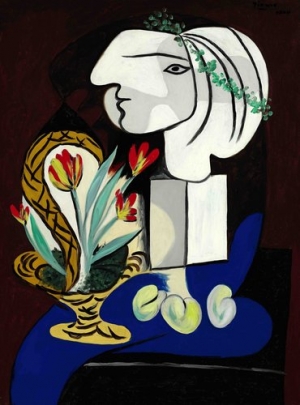
The top sale at last night’s Impressionist and modern Art auction at Sotheby’s in New York was a 1932 painting by Pablo Picasso of his muse, Marie-Therese Walter. The suggestive Nature Morte aux Tulipes, estimated at $35 to $50 million, sold to a phone bidder for $41.5 million.
The sale at Sotheby’s took place just one day after Christie’s lackluster Impressionist and modern art auction and didn’t fare much better than its predecessor. While there were some notable sales, 31% of lots went untouched including mid-level works by Degas and Rodin. While many have been blaming the election and unfortunate weather for the mixed sales, the quality of the work featured has also in question. Many have taken note of the padded sales by both auction houses and during these delicate economic times, buyers want to spend money on exceptional works, not mediocre works by exceptional artists.
On a positive note, there were a number of impressive sales besides the Picasso portrait. Claude Monet’s 1881 landscape Champ de Blé estimated at $5 to $7 million fetched $12.1 million and a photograph of Marcel Duchamp taken by Man Ray sold for $2.4 million, well over it’s $1.7 million high estimate. Another work that exceeded expectations was Fernand Leger’s Les Contructeurs, which went for $1.37 million, more than double its low estimate. The sale brought in $163 million; it was expected to garner about $169 million in total.
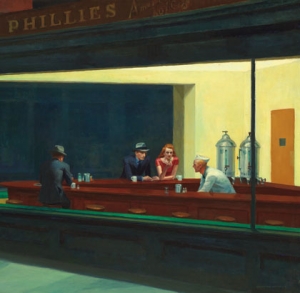
Best known for his paintings of stark diner scenes, snapshots of city life, and quiet portraits of the American landscape, there is much more to Edward Hopper’s (1882–1967) oeuvre than one might think. Referred to as a romantic, a realist, a symbolist, and even a formalist, the exhibition, Paintings by Edward Hopper (1882–1967) currently on view at the Grand Palais, Galeries Nationales in Paris aims to explore each facet of Hopper’s artistic identity.
Divided chronologically into two main parts, the first section of the exhibition covers Hopper’s early work from 1900 to 1924. During this time Hopper studied at the New York School of Art under Robert Henri, the founder of the Ashcan School of realism. Hopper also spent nearly a year in Paris in 1906, followed by shorter stays in 1909 and 1910.
The first part of the exhibition sets out to compare Hopper’s early work to that of his contemporaries as well as to the art he saw while in Paris. While in Europe, Hopper was influenced by such things as Degas’ original angles to Vermeer’s use of light. He was also moved by the soft, harmonious nature of Impressionism, which is reflected in his work from the time. This work is in sharp contrast to the almost gritty realism Hopper favored back in the United States.
1924 marked a turning point in Hopper’s career. After successful exhibitions of his watercolors of neo-Victorian houses in Gloucester, Massachusetts at the Brooklyn Museum and the Franck Rehn’s Gallery (New York), Hopper enjoyed commercial success and was able to fully devote his life to his art. Hopper’s watercolors mark the second section of the Grand Palais exhibition and feature the iconic paintings most people associate with the artist.
Curated by Didier Ottinger, assistant director of the MNAM – Center Pompidou, the exhibition of Hopper’s work will be on view through January 28, 2013.
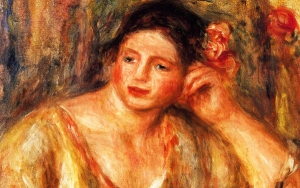
As of yesterday, a Pierre-Auguste Renoir (1841–1919) painting that was stolen during an armed robbery at a Houston home last September has been named one of the FBI’s top ten unsolved art crimes. A private insurance company has offered a $50,000 reward for any helpful information leading to the work’s recovery.
The painting, Madeleine Leaning on Her Hair, was completed by the pioneering Impressionist in 1918 and has an estimated value of $1 million. The painting has also been added to the Art Loss Registry, the National Stolen Art File, and Interpol’s Works of Art System. Interpol, an international police organization, encourages cooperation between law enforcement agencies in different countries. By taking these measures, the thief will most likely be unsuccessful if he/she attempts to take the painting to a knowledgeable dealer or gallery or tries to sell it at auction as most members of the art world regularly check these databases.
The other top unsolved art crimes on the FBI’s list include the notorious Isabella Stewart Gardner Museum heist in which four Rembrandts, five Degas drawings, and one Vermeer (among other works) were stolen. Also on the list is the theft of two Gloria Vanderbilt Whitney commissioned Maxfield Parrish paintings from a Hollywood gallery, the 2002 van Gogh Museum robbery in which two paintings valued at $3 million, and the 1969 theft of a $20 million Caravaggio from Italy’s Oratory of San Lorenzo.
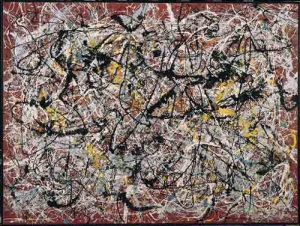
It is the finest collection of modern art anywhere outside Europe and the US, boasting works by Jackson Pollock, Francis Bacon, Andy Warhol, Edvard Munch, René Magritte and Mark Rothko.
But the pieces have been stacked in the basement of Tehran's Museum of Contemporary Art for more than 30 years, gathering dust in storage. Censors in Iran classed some as un-Islamic, pornographic or too gay, and they have never been shown in public. Others have been displayed only once or twice.
But now a number of the collection's paintings are on show for the first time in Tehran as part of the museum's Pop Art & Op Art exhibition, featuring works by Warhol, David Hockney, Roy Lichtenstein, Victor Vasarely, Richard Hamilton and Jasper Johns.
"Many of the works in the exhibition are shown for the first time," Hasan Noferesti, the museum's director for art programmes, told the Mehr news agency. "The exhibition aims to show the evolution of these artistic movements."
More than 100 pieces from the museum's remarkable collection are on display, according to Mehr, along with a series of works from Mexico that have been dedicated to the museum in commemoration of the 100th anniversary of the Mexican revolution and the 200th anniversary of the country's independence.
James Rosenquist, Jim Dine, Larry Rivers and RB Kitaj are among other artists whose works are in the exhibition, which runs until mid-August.
Iran's unique hidden treasure was bought before the Islamic revolution, under the supervision of Farah Pahlavi, the former queen of Iran, who fled the country with the late shah Mohammad Reza Pahlavi in 1979.
The 38-year reign of the shah, self-proclaimed kings of kings, came to an end after Ayatollah Ruhollah Khomeini returned from exile to Tehran receiving a hero's welcome and founded the Islamic republic.
The collection includes Pollock's Mural on Indian Red Ground, considered to be one of his most important works and estimated to be worth more than $250m, as well as important pieces by Picasso, Van Gogh, Monet, Pissarro, Renoir, Gauguin, Toulouse-Lautrec, Degas, Whistler and Marcel Duchamp.
There are even pieces by artists whom the former empress met in person, including the Russian-French painter Marc Chagall and the English sculptor Henry Moore. The collection is thought to be worth more than $2.5bn.
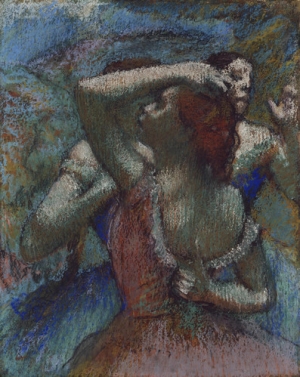
Edgar Degas was a secretive type. One day a pioneer movie maker knocked on his door and asked if he could film him.
“I have absolutely nothing to say to you,” replied the great man. He wasn’t much more forthcoming about his art.
A new exhibition at London’s Royal Academy of Arts aims to penetrate some of Degas’s mysteries. One of his signature subjects was the ballet, specifically ballerinas -- on stage and off, practicing, single and in groups.
There’s a temptation to dismiss these pictures, with their pastel colors and flocks of young women in frilly skirts, as so much visual fluff: chocolate box stuff. The works in the show “Degas and the Ballet: Picturing Movement” have ended up on plenty of greetings cards and calendars.
The curators of the RA exhibition, Richard Kendall and Jill Devonyar, suggest that Degas’s real interest was in analyzing movement, not in tutus and bodices. The point of the exercise is a sequence of comparisons between works by Degas and images that belong as much to the history of science as to art.
It’s the austere kind of show in which the visitor has to pay attention to the argument, rather than just relax and enjoy. That said, it offers insights into a supreme painter’s world.
Capturing precisely how humans and animals moved was an obsession of the age in which Degas lived (1834-1917). The Anglo-American Eadweard Muybridge and Frenchman Etienne-Jules Marey used unprecedentedly rapid camera speeds to record motion, a development that led to cinema: pictures that actually moved.
Fleeting Instants
A number of animated images by Muybridge and others flicker into life on the walls of the RA. In his drawings and paintings, hung nearby, Degas was focusing on just such fleeting instants.
When he began to work in three dimensions, Degas made studies of the model for his sculpture “Little Dancer Aged Fourteen” (1880-81) from 26 positions around her. This procedure was similar to a forgotten process dubbed “photosculpture,” in which the subject was photographed from numerous angles, and the results mechanically transferred to a piece of clay.
Similarly, Degas’s use of a wide, low format for a series of pictures he called “friezes” closely paralleled a vogue for panoramic photography. The results in pictures such as “The Dance Lesson” (circa 1879) are the equivalent in painting of a cinematic panning shot. When Degas himself took up photography, he preferred atmospheric interiors by night, not figures in motion.
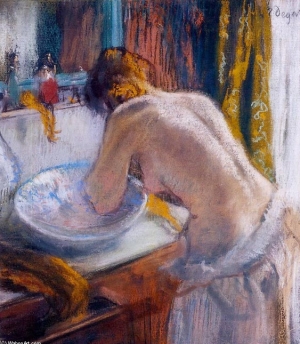
The first museum exhibition devoted exclusively to the extraordinary range of nudes by Edgar Degas—tracing their evolution from the artist’s early years, through the private and public images of brothels and bathers in the 1870s and 1880s, to the post-Impressionist nudes of the end of his career—will be presented by the Museum of Fine Arts, Boston (MFA), and the Musée d’Orsay, Paris. Degas and the Nude, on view October 9, 2011, through February 5, 2012, at the MFA, will offer a groundbreaking examination of Degas’s concept of the human body during the course of 50 years by showing his work within the broader context of his forebears, contemporaries, and followers in 19th-century France, among them Ingres, Delacroix, Cassatt, Caillebotte, Renoir, Toulouse-Lautrec, Matisse, and Picasso. Assembled from the collections of more than 50 lenders from around the world are approximately 165 works—145 by Degas—including paintings, pastels, drawings, monotypes, etchings, lithographs, and sculptures, many of which have never been on view in the United States. After its debut in the MFA’s Ann and Graham Gund Gallery—its only US venue—Degas and the Nude will be shown at the Musée d’Orsay from March 12–July 1, 2012. Presentation of the exhibition in Boston is made possible by Bank of America. This exhibition is supported by an indemnity from the Federal Council on the Arts and the Humanities.
The 19th-century French artist Edgar Degas (1834–1917), a founding member of the Impressionist group who gravitated toward realism, is acclaimed for his mastery of a wide range of genres, which he executed in all media using a variety of techniques. In addition to his famous depictions of ballet dancers or racing subjects, Degas’s work also included history paintings, portraits, landscapes, and scenes of urban leisure. This exhibition, however, will focus entirely on his nudes, illustrating the transformation of Degas’s treatment of the human form throughout half a century—from early life drawings in the 1850s, to overtly sexual imagery, to gritty realist nudes, and beyond to the lyrical and dynamic bodies of the last decade of his working life when the theme dominated his artistic production in all media.
“Degas and the Nude will be a revelation for our visitors. It will offer a number of surprises—for instance, we’ll reunite several of Degas’s black-and-white monotypes with the corresponding pastel ‘twins’ for the first time since they left the artist’s studio,” said Malcolm Rogers, Ann and Graham Gund Director of the MFA. “Visitors will see the progression of his nudes and the very heart of Degas’s fascination with the body and its range of emotion and movement. He pursued that fascination in portraits, and above all in images of dancers, but in the nude we see the body in its purest form…through Degas’s eye and imagination.”
Degas and the Nude draws from some of the finest collections in the world. In addition to the MFA and Musée d’Orsay—the single largest lender, with more than 60 works—these include the National Gallery and Courtauld Gallery, London; the Musée Andre Malraux, Le Havre; museums and private collections in Germany, Japan, and Switzerland; as well as the Metropolitan Museum of Art, the Art Institute of Chicago, and the Philadelphia Museum of Art, among many other museums and private collections in North America. The exhibition will feature such masterpieces as Young Spartans Exercising (1860-62, National Gallery, London) and Scene of War in the Middle Ages (1863–65, Musée d’Orsay, Paris), two of Degas’s greatest history paintings; and The Tub (about 1886, Musée d’Orsay), a pastel completed at the height of his career and presented at the last Impressionist exhibition in 1886. It will also offer context to this exploration of the artist’s nudes by juxtaposing his works with those created by major artists who influenced—or were influenced by—Degas, including Ingres’s Angelica Saved by Ruggiero (1819-39, National Gallery, London), Caillebotte’s Man at his Bath (1884, Private Collection), and Picasso’s Nude on a Red Background (1906, Musée de l'Orangerie, Paris).
More than three years in the making, Degas and the Nude was conceived by George T.M. Shackelford, Chair, Art of Europe and Arthur K. Solomon Curator of Modern Art at the MFA, who co-organized the exhibition with Xavier Rey, Curator of Paintings, Musée d'Orsay. “Our project explores how Degas exploited all of the body’s expressive possibilities,” Shackelford said. “It shows how his personal vision of the nude informed his notion of modernity, and how he abandoned the classical or historical form in favor of a figure seen in her own time and setting, whether engaged in shockingly carnal acts or just stepping out of an ordinary bath.”
“The first works by Degas to enter the collections of the French State were pastels of nudes bequeathed to the nation by Gustave Caillebotte in 1894,” said Xavier Rey, exhibition co-curator. “In the ensuing century, the Musée d’Orsay has become The Tub, 1886, Edgar Degas the world’s greatest repository of Degas’s depictions of the nude—in paintings, pastels, drawings, and sculpture. We take pride in co-organizing this major international project, which will be one of the important exhibitions in Paris in 2012.”
Degas and the Nude is organized into six sections, which will explore:
- Degas’s earliest nudes, from about 1855 to 1862
- The artist’s early masterwork, Scene of War in the Middle Ages, and the studies that preceded it
- Brothel monotypes Degas executed in the latter half of the 1870s
- Transformation of Degas’s brothel imagery to scenes of daily life
- Select works from the artist’s key years of 1884–86
- Degas’s last years as an artist, from about 1890 to 1905
The exhibition will begin with a selection of the artist’s first nudes, including Study of Michelangelo’s Bound Slave (1855–60, Private Collection), one of Degas’s many studies of works by Renaissance artists that he made in Paris or in Italy, where he drew from live models at Rome’s French Academy. Many life studies and paintings created as part of this early academic training will be on display, as well as drawings made for early figural compositions, culminating in the painting Young Spartans Exercising (1860–62, National Gallery, London), a depiction of girls beckoning or taunting a group of boys, with the landscape of ancient Sparta as a background.
One of Degas’s most notable works incorporating nudes, the history painting Scene of War in the Middle Ages, will be the focal point of the second section of the exhibition. The often overlooked masterpiece was the first work Degas exhibited at the official Salon in 1865. It will offer an early view of some of the many poses the artist would repeat throughout his career. Complementing it will be more than a dozen of the studies that preceded it, as well as works by other artists who exerted an influence on Degas in the conception and elaboration of the painting, such as Jean Auguste Dominique Ingres (1780–1867), whose Angelica Saved by Ruggiero will be displayed along with a masterwork by Eugène Delacroix (1798–1863): The Death of Sardanapalus (1844, Philadelphia Museum of Art). These two French masters, as well as artists such as Francisco de Goya y Lucientes (1746–1828) and Pierre Puvis de Chavannes (1824–1898), provided inspiration for the young Degas. Two paintings by Degas from the later 1860s also will be shown: Interior (The Rape) (1868–69, Philadelphia Museum of Art) and Peasant Girls Bathing in the Sea at Dusk (about 1869, revised later, Private Collection).
The exhibition’s third section will be devoted to the brothel monotypes that Degas executed in the latter half of the 1870s— images that are at times caricature-like, ironic, pornographic, or even unexpectedly tender. These often sexually explicit scenes depict women in brothels: waiting for clients, as in The Reluctant Client (1876-77, National Gallery of Canada), and engaging in sexual acts, as in Two Women (1876–77, MFA). Most of these works are relatively small in scale, made as drawings using brush and greasy ink on metal plates, which were then printed to yield one proof (“mono-type”); sometimes a second, fainter, impression was taken. The monotypes were occasionally touched with pastel; some—more often the second impressions—were completely covered with color to become small pictures, ready for sale or gift.
The evolution of Degas’s nudes will continue in a following section, shifting from overtly sexual imagery to the everyday, “naturalist” nudes, as seen in the artist’s spontaneous views of ordinary, seemingly unposed women at various stages of undress or performing “la toilette”—bathing, drying, or grooming themselves. These monotypes will highlight the emergence of the bather as a central theme in Degas’s art—one that he would explore from the middle of the 1880s until the end of his career. Many of these later monotypes were made in a way that differed from the first ones, showing the artist’s interest in exploring a variety of techniques and materials. Rather than painting his image with a brush, Degas inked the entire plate and “pulled” the image out of the ink with selective wiping and scraping. In this section, some monotypes will be united with their corresponding pastels for what is believed to be the first time. These include the monotype Woman in a Bathtub (about 1850–85, Private Collection), and the pastel over monotype Woman in Her Bath, Sponging her Leg (1883–84, Musée d’Orsay). Other pastels and oil paintings will be featured here, as well as comparisons to the work of Mary Stevenson Cassatt (1844–1926), Woman Bathing (1890–91, The Metropolitan Museum of Art), and Henri de Toulouse-Lautrec (1864–1901), La Toilette (Rousse) (1889, Musée d’Orsay). The section will culminate in a group of large-scale oil paintings by Degas and his friends Gustave Caillbotte (1848–1894) and Henri Gervex (1852–1929), made between the years 1878 and about 1884.
Works from a pivotal time in Degas’s career, 1884–86, will be examined in section five of the exhibition. Two examples, The Tub (1885–86, Musée d’Orsay) and Woman Dressing Herself (1885–86, National Gallery of Art, Washington, DC) were included in the last Impressionist exhibition, held in Paris in the spring of 1886. In addition, comparative paintings by Pierre- Auguste Renoir (1841–1919), Woman Combing Her Hair (1882–83, Private Collection), and Puvis de Chavannes, Young Woman at Her Toilette (1883, Musée d’Orsay), will be displayed, as well as works from the late 1880s that expand upon those created a few years earlier. Also included will be the sculpture The Tub (Musée d’Orsay, 1889 modeled, cast 1920–21), cast in bronze after the artist’s death.
Degas and the Nude will conclude with an exploration of Degas’s last years as an artist, from about 1890 to 1905. “During this period, Degas is focused almost exclusively on the bather, with the exception of a few great drawings and sculptures depicting dancers. His color sense grows bolder, and as he nears the end of the 1890s, his painting and drawing technique become more experimental and, likewise, more bold,” explained Shackelford. “Influences of such artists as Gauguin and Rodin are felt in his painted compositions and sculpture. Sinuous lines, sensual hatchings, delicate blending and shading, and large scale mark his later charcoal drawings of bathers, among the most accomplished sheets in his career, and a radical departure from the carefully rendered nudes of 1855–1865.” Featured here will be the largest single grouping in the exhibition, which will showcase Degas’s masterpieces, After the Bath (about 1896, Philadelphia Museum of Art) and After the Bath (1895-1900, The Phillips Collection, Washington, DC). In addition, to illustrate Degas’s influence on the next generation of great artists, paintings by Degas will be juxtaposed with those by Pierre Bonnard (1867–1947), Henry Matisse (1889–1954), and Pablo Picasso (1881–1973). In the context of Degas’s great nudes of the 1890s, Bonnard’s Indolence (1899, Musée d’Orsay), Matisse’s Carmelina (1903, MFA), and Picasso’s Nude on a Red Background (1906, Musée de l'Orangerie, Paris) take on new meaning, as masterworks by the youthful standard-bearers of Degas’s post-Impressionist style in a new century.
|
|
|
|
|